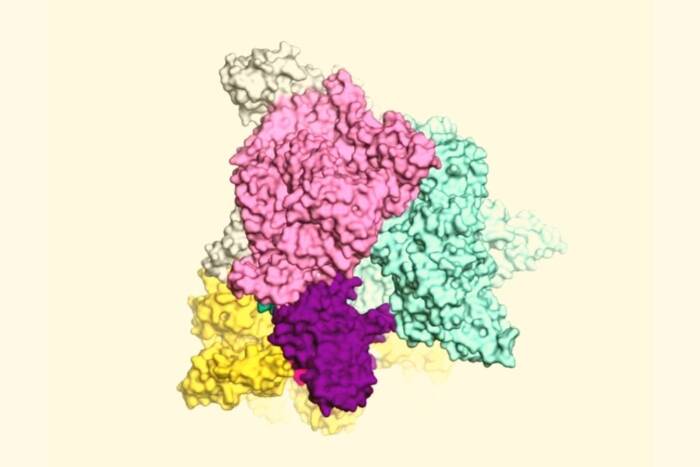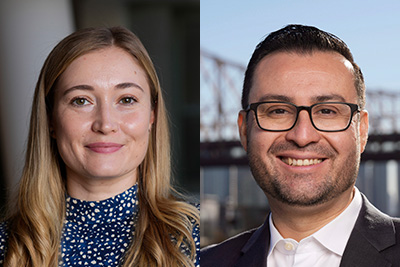Smogorzewska and Tavazoie named associate professors
Agata Smogorzewska and Sohail Tavazoie, physician-scientists who joined Rockefeller in 2009, have both been promoted this year to the rank of associate professor. Dr. Smogorzewska, who studies DNA repair processes that occur during cellular replication, is head of the Laboratory of Genome Maintenance. She was promoted in July. Dr. Tavazoie, promoted in January, is the head of the Elizabeth and Vincent Meyer Laboratory of Systems Cancer Biology and works to understand how cancer cells escape tumors and invade other organs in a process known as metastasis.
Dr. Smogorzewska received her Ph.D. from Rockefeller in 2002, where she was a member of Titia de Lange’s lab, and her M.D. from Weill Cornell Medical College in 2003. She did a clinical pathology residency at Massachusetts General Hospital, and postdoctoral work in Stephen Elledge’s lab at Harvard Medical School. In Elledge’s lab, she identified the gene FANCI, part of a pathway that removes inappropriate attachments between DNA strands, a process called DNA interstrand crosslink (ICL) repair. Mutations in this gene, or other members of the pathway, result in Fanconi anemia, which brings infertility, bone marrow failure, and a high incidence of cancer.
“The genome is constantly accumulating damage—from sunlight, from toxins, and during DNA replication—which together can introduce thousands of lesions. If these errors are not fixed, or are fixed incorrectly, the result can be cancer or problems with the maintenance of stem cells, such as those in the bone marrow that give rise to blood cells,” Dr. Smogorzewska says. “My lab investigates repair that occurs while the cell is copying its genome, and we do so through the lens of rare genetic disorders, such as Fanconi anemia and the kidney disease karyomegalic interstitial nephritis, in which this pathway does not function as it should.”
Since arriving at Rockefeller in 2009, Dr. Smogorzewska has sought to uncover the molecular mechanisms of interstrand crosslink repair and to understand how dysfunction in this repair leads to disease. The university’s International Fanconi Anemia Registry (IFAR), which now includes information and cell lines from more than 1,000 families, has provided a powerful tool to help her lab identify the genes involved—information that can then be used to tease out the mechanistic aspects of the pathway. Her lab has started by sequencing samples from patients for whom the genetic cause of their Fanconi anemia was unknown. To date it has identified three new Fanconi anemia genes, SLX4/FANCP, UBE2T/FANCT, and RAD51/FANCR, with more candidate genes in the pipeline.
The Smogorzewska lab has shown that the DNA-repair protein known as SLX4 played a critical role in DNA interstrand crosslink repair and that mutations in the SLX4 gene caused Fanconi anemia. SLX4 is an unusual protein in that it binds to three separate nucleases, enzymes that cut DNA. These nucleases are essential for the repair of ICLs and other errors during replication, and Dr. Smogorzewska is investigating how SLX4 regulates these pathways. More recently, Dr. Smogorzewska and her colleagues discovered a third Fanconi anemia gene, RAD51/FANCR, which was already known to be important for another DNA repair process, called homologous recombination.
“Identification of new genes is a terrific point of entry to understand the mechanism and function of interstrand crosslink repair. The registry has been an amazing resource and Rockefeller provides the most engaging and stimulating environment for me and for the talented scientists in my lab,” she says.
A number of projects, including the ongoing search for new genes important for DNA repair, are now underway in her lab. Among them, she is studying the pathogenesis of karyomegalic interstitial nephritis, which arises from mutations in the FAN1 gene, another component of the interstrand crosslink repair pathway, which the lab identified. Dr. Smogorzewska is also beginning to catalog and assess the genomic changes in Fanconi anemia patients who developed head and neck cancers.
“In her six years as a Rockefeller head of laboratory, Agata has proven, time and again, her dedication to conducting the highest caliber science and to mentoring younger scientists, and we are fortunate to have her as a member of our community,” says Marc Tessier-Lavigne, the university’s president. “Using patient data to not only better understand devastating disease, but also to elucidate fundamental DNA repair mechanisms essential to human health, Agata is revealing exciting new insights about an important pathway, and, more broadly, into the means by which the human genome protects its integrity against constant assault.”
Dr. Tavazoie, who received his graduate and clinical training at Harvard Medical School, gravitated toward oncology as a student and began working on metastasis in breast cancer cells as a postdoc at Memorial Sloan Kettering Cancer Center (MSKCC). After arriving at Rockefeller, he expanded his work to include colon cancer and melanoma.
“Metastasis is the major cause of death among cancer patients, but there is still much we don’t understand about this process, such as how metastatic tumors form, progress, and grow,” Dr. Tavazoie says. “My lab’s main goal is to identify the genes and molecular pathways cancer cells exploit in order to metastasize and, with that knowledge, we hope to develop future treatments to prevent or interfere with it.”
His lab first identifies specific micro-RNAs by looking for changes in highly metastatic versus poorly metastatic tumor cells. They then use these microRNAs as a sort of flashlight that shines light into the complex biology—the genes and molecular pathways—involved in metastasis, Dr. Tavazoie says.
This approach has revealed, for example, that highly metastatic breast cancer and melanoma cells exploit different microRNAs in order to attract endothelial cells, which typically line blood vessels. This is an important step in establishing a metastatic colony far from the original tumor.
“I feel fortunate to have been able to recruit such a tremendous group of scientists to my lab, who have really propelled these studies forward. Rockefeller has provided a phenomenal environment for supporting this work, and it has been great to collaborate with MSKCC, where I am continually inspired by the patients I see,” says Dr. Tavazoie, who is also an attending oncologist at MSKCC and a physician at the Rockefeller University Hospital.
Current work in Dr. Tavazoie’s lab delves deeper into the details of metastasis-promoting pathways, exploring, for instance, how cancer cells benefit by recruiting endothelial cells, and how cancer cells change the levels of microRNAs within them. He and colleagues are currently working on developing two candidate therapies that take advantage of the new knowledge of the mechanisms behind metastasis.
“In his six years at Rockefeller, Sohail has made himself an integral part of the university and the Tri-Institutional community, building an innovative research program based on both basic biology and clinical observations,” says Dr. Tessier-Lavigne. “His research has uncovered critical mechanisms behind the deadly process of metastasis, and the insights emerging from his lab have the potential to address one of the great epidemics of our age, cancer. It is a pleasure to an-nounce his promotion to associate professor.”



